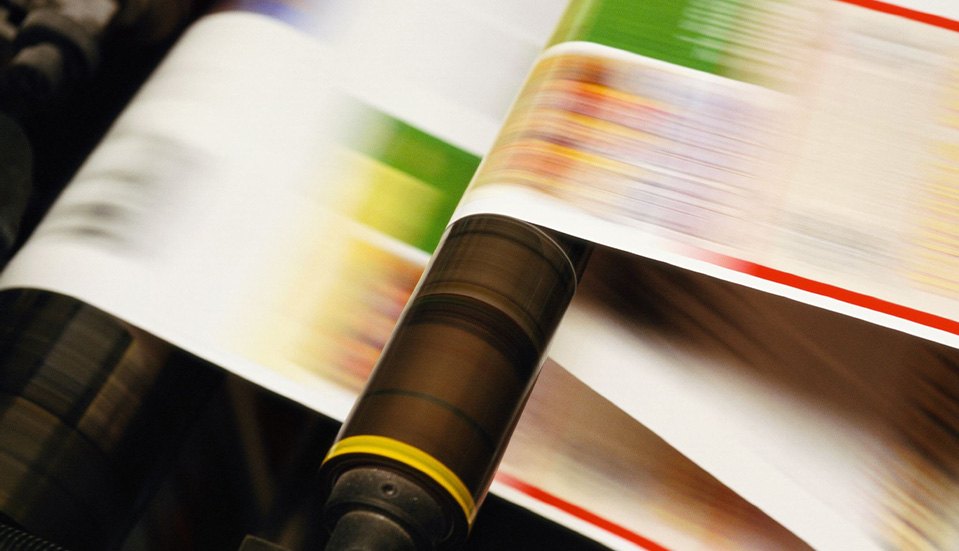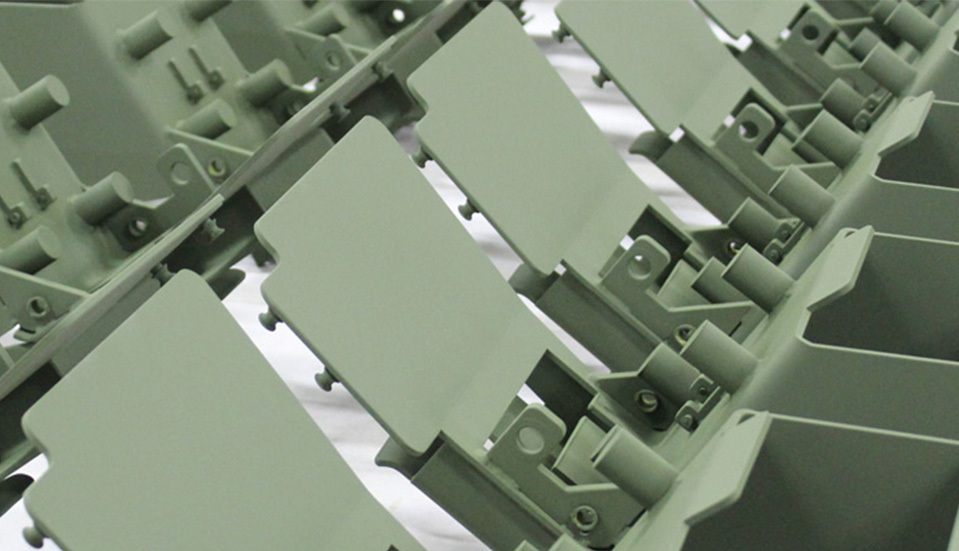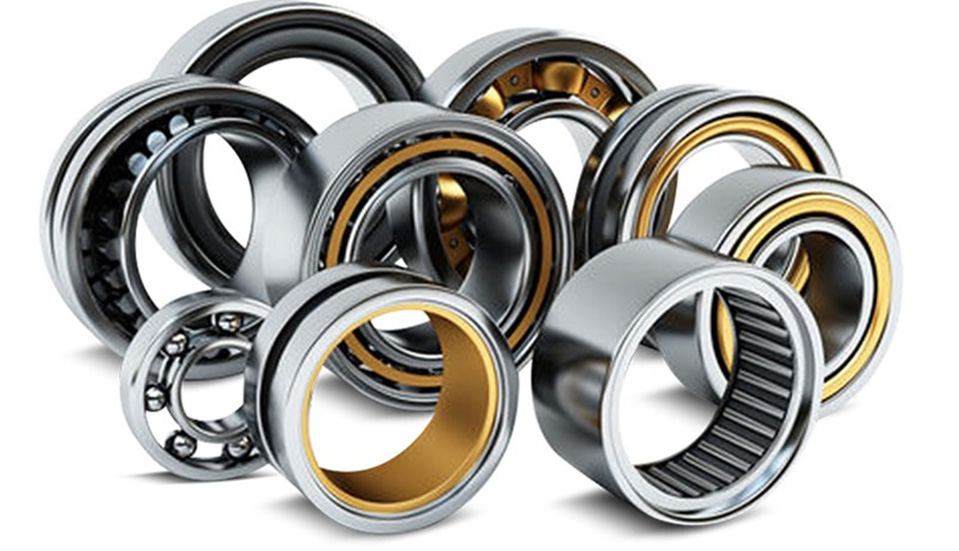Surface finishing is a broad range of industrial process used to artificially form a layer of surface that is different with the substrate material mechanically, physically and chemically on the surface of substrate. This process is normally employed to improve the corrosion resistance, abrasion resistance, chemical resistance, decoration or other functional requirements of manufactured items. Among the benefits obtained from surface finish processes, the following are key:
Below is a list of value-added services that our proven suppliers offer to support our precision machining and metal fabrication capabilities.

Powder Coating
Powder coating is a type of finish applied to metal parts to create a cosmetic and durable coating. Unlike liquid paint, powder coat is applied as a dry powder using electrostatic which does not require a solvent. As a result, powder coating results in a thick, dense finish on metal products which can be more durable and longer-lasting than conventional painting. We routinely use polyesters, epoxies, nylons, vinyl, Kynar, Halar, Teflon and many other types of powder.
Wet Paint
The benefits of wet paint are quite complimentary to powder coating. Wet paint is ideal for products which cannot be heated for powder coating because wet paint does not require an oven for curing. Wet paint can produce a much thinner finish than powder coating. Products which demand a thin finish can benefit greatly from wet paint.

Dry film lubricants or solid film lubricants are materials that reduce friction between surfaces in many extreme environments including those with high and low temperature, high and low pressure and where liquids and oils cannot be used. This coating is an attractive alternative to fluid lubricants for minimizing friction and preventing seizing and galling, especially in high or low temperature environments where fluids may freeze or vaporize. we offer a wide range of lubricant coating options, protecting items from the smallest fasteners to massive industrial components that require a coating to reduce friction.
Using a spray application and a baked curing process, (required for most applications), we are able to meet the requirements of the Defense and Aerospace industries, as well as other commercial requirements.
Types of Lubricant:

MIL-A-8625 TYPE I
Coating for aluminum.
NOTE: INSTEAD OF CHROMIC ANODIZE, USE SULFURIC ANODIZE FOR MOST APPLICATIONS – SEE MIL-A-8625 TYPE II.
Color will vary from light to dark gray depending on the base alloy.
Not as readily dyed as Sulfuric Anodize.
Can be used for inspection of aluminum forgings or castings by noting evidence of chromic acid bleed from laps, cracks, seams, etc. Unless otherwise specified, coating will be sealed. metal salt sealants should not be used on items that will be painted.
Shall not be applied to aluminum alloys with over 5.0% copper, 7.0% silicon, or total alloying constituents over 7.5%. When copper content is less than 4.6% and for all suitable casting alloys, be aluminum alloy is to be tempered (T4 or T6).
Thickness buildup: .00002" - .0003" because of thinness will scratch easily. Class 1: non-dyed (natural color, including dichromate sealing). 200 MG/SF minimum. Class 2: dyed. 500 MG/SF minimum.
EXAMPLE SPECIFICIATION: CLEAR ANODIZE. REFERENCE MIL-A-8625 TYPE I CLASS 1
MIL-A-8625 TYPE II
Coating for aluminum. Color will vary from light to dark gray depending on alloy. Aluminum with low alloying elements will show practically no color change.
Best coating on aluminum for dyeing. Can be dyed practically any color or shade (black, blue, red, etc). FED-STD-595 may be used as a guide to color spec (approximate comparison only).
Thickness buildup: .00007" - .0010" moderate abrasion resistance. Class 1: non-dyed. 600 MG/SF minimum. Class 2: dyed. 2500 MG/SF minimum.
EXAMPLE SPECIFICIATION: BLUE ANODIZE. REFERENCE MIL-A-8625 TYPE II CLASS 2
MIL-A-8625 TYPE III
Coating for aluminum. Color will vary from light tan to black depending on alloy and thickness. Can be dyed in darker colors depending on thickness. Coating penetrates base metal as much as buildup on the surface. The term thickness includes both the buildup and penetration. Provides very hard ceramic type coating. Abrasion resistance will vary with alloy and thickness of coating. Good dielectric properties. Corrosion resistance is good; recommend seal hard anodize in 5% dichromate solution where increased corrosion resistance is required. Where extreme abrasion resistance is required do not seal as some softening will result. Thick coatings (over .004") will tend to break sharp edges.
Thickness .002" to .0005" typical - or as specified on drawing.
Class 1: non-dyed.
Class 2: dyed.
EXAMPLE SPECIFICIATION: HARD BLACK ANODIZE. REFERENCE MIL-A-8625 TYPE III CLASS 2
MIL-C-13924
A uniform black coating for ferrous metals.
Mostly a decorative coating. For moving parts which cannot tolerate the dimensional change of a more corrosion resistant finish.
For decorative applications and can be used to decrease light reflection. Only very limited corrosion protection under mild corrosion conditions.
Black oxide coatings should normally be given a supplementary treatment (oil displacement per MIL-C-16173 Grade 3).
Class 1: Alkaline oxidizing. For wrought iron, plain carbon, and low alloy steels. Class 3: Fused salt oxidizing. For steels having draw temp above 900F. Class 4: Alkaline oxidizing. For corrosion resistant steels.
EXAMPLE SPECIFICIATION: BLACK OXIDE. REFERENCE MIL-C-13924 CLASS 1
QQ-P-416
Because of health hazards, THIS PROCESS IS NOT RECOMMENDED.
A coating for ferrous metals.
Bright silvery white. Supplementary treatments for TYPE II can be golden, iridescent, amber, black, olive drab. Corrosion resistance is very good, especially with TYPE II finish. TYPE II shall show no surface corrosion products after 96 hours (20%) salt spray exposure. Parts with hardness greater than RC-40 shall be stress- relieved before cleaning and plating. Parts subject to flexure (springs) over RC-40 hardness shall be given a 375F post-bake. Excellent for plating stainless steels that are to be used in conjunction with aluminum to prevent galvanic corrosion.
TYPE I: No supplementary treatment.
TYPE II: Supplementary chromate treatment. Best for corrosion resistance.
TYPE III: Supplementary phosphate treatment. Used as a paint base
Class 1: .0005" min plating thickness
Class 2: .0003" min plating thickness
Class 3: .0002" min plating thickness
Salt spray test TYPE II 96 hours - check for white corrosion products.
EXAMPLE SPECIFICIATION: DONT USE CADMIUM ANYMORE, PLEASE.
MIL-C-5541
Coatings for aluminum, zinc, silver, and cadmium.
Color can vary from colorless to iridescent yellow/brown. Coatings shall be continuous, free from powdery areas, breaks, scratches, etc. used mainly as a base for paint, and where conductivity and corrosion resistance is required.
Class 1a: For maximum protection against corrosion, typically the final finish. May also be used as a base for paint.
Class 3: For maximum conductivity where low electrical resistance is required. Salt spray test 168 hours.
EXAMPLE SPECIFICIATION: CLEAR CHROMATE.
REFERENCE MIL-C-5541 CLASS 3.
YELLOW CHROMATE. REFERENCE MIL-C-5541 CLASS 1A
QQ-C-320
A coating for ferrous metals.
Excellent hardness (RC68-74), wear resistance, and erosion resistance. Has low coefficient of friction, and is resistant to heat. Can be rendered porous for lubrication purposes.
TYPE I: Bright
TYPE II: Satin
Class 1: .00001"-.00002" min thickness. Decorative plating usually over copper and nickel undercoats)
Class 2: Thickness as specified on drawing. Engineering plating. Class 2a: Thickness as specified on drawing. Post bake 375F for 3 hours.
Class 2b: For parts below RC-40 and subject to static loads or designed for limited life under dynamic loads. Shot peening and post bake not required.
Class 2c: For parts below RC-40 and designed for unlimited life under dynamic loads. Shot peen per MIL-S-13165.
Class 2d: For parts above RC-40 and subject to static loads or designed for limited life under dynamic loads. Post bake at 375F for 3 hours.
Class 2e: For parts above RC-40 and designed for unlimited life under dynamic loads. Shot peen before plate. Post bake at 375F for 3 hours.
EXAMPLE SPECIFICIATION: CHROME PLATE. REFERENCE QQ-C-320 TYPE 1 CLASS 1
MIL-C-14550
A coating for ferrous and nonferrous metals.
Copper in color and matte to very shiny finish. Good corrosion resistance when used as undercoat. A number of copper processes are available, each designed for a specific purpose: brightness (to eliminate the need for buffing); high speed (for electroforming); fine graining (to prevent case hardening); etc.
Class 0: .001" - .005" thickness. Stop-off for heat treat. Class 1: .001" thick. stop-off for carburizing. Shielding for brazing. Class 2: .0005" thick. as an undercoat for nickel and other platings. Class 3: .0002" thick. to prevent base metal migration into tin (prevents poisoning solderability) Class 4: .0001" thick. to prevent base metal migration into tin (prevents poisoning solderability)
EXAMPLE SPECIFICIATION: COPPER PLATE. REFERENCE MIL-C-14550 CLASS 1
Process electrolytically removes or diminishes scratches, burrs and unwanted sharp edges from most metals.
Finishes from satin to mirror- bright are produced by controlling time, temperature, or both. Typically removes .0002" - not recommended for close tolerance surfaces.
MIL-G-45204
Yellow to orange in color depending on proprietary process used. Will range from matte to bright finish depending on base metal. good corrosion resistance, and has high tarnish resistance. Soft 24k gold will have hardness of about 90 knoop. Hard 23k gold will have hardness up to 300 knoop. Provides low electrical resistance.
TYPE I: 99.7% gold - used on most industrial applications.
TYPE II: 99.0% gold - hard plate where wear is important.
TYPE III: 99.9% gold - electronic applications.
Class 00 - .00002" - decorative gold flash Class 0 - .00003" - decorative gold flash Class 1 - .00005" - over silver underplate Class 2 - .00010" - wave guides/contacts Class 3 - .00020" - standard engineering use Class 4 - .00030" - for corrosion/wear Class 5 - .00050" - for corrosion/wear Class 6 - .00150" - cathode emission
EXAMPLE SPECIFICIATION: GOLD PLATE. REFERENCE MIL-G-45204 TYPE III CLASS 2
QQ-N-290
Coating for steel, copper, copper alloys, zinc and zinc alloys.
Nickel can be deposited soft or hard, dull or bright, depending upon process used and conditions employed in plating. Thus hardness can range from 150-1500 Vickers. Can be similar in color to stainless steel, or can be a dull gray or light gray (almost white).
Corrosion resistance is a function of thickness. Has a low coefficient of thermal expansion. is magnetic. All steel parts having hardness of RC-40 or greater require a post bake at 375F for 3 hours. All steel parts having tensile strength of 220,000+ shall not be nickel plated without specific approval of buyer. steel and zinc alloys shall have copper underplate .0002" min. copper alloys containing 40%+ zinc shall have copper underplate .0003" min.
Class 1: for decorative application on steel, zinc, copper.
Grade A: .0016" thick
Grade B: .0012" thick
Grade C: .0008" thick
Grade D: .0008" thick
Grade E: .0006" thick
Grade F: .0004" thick
Grade G: .0002" thick
Class 2: .003" thick - or as specified on drawing.
EXAMPLE SPECIFICIATION: NICKEL PLATE. REFERENCE QQ-N-290 CLASS 1 GRADE C
MIL-A-63576 TYPE I
Nituff is a proprietary teflon penetrated hard coat anodize provided by Nimet Industries, usually applied to 6061-T651 aluminum.
This process provides surface hardness of 60 to 70RC, reduction of friction without lubricants, and resistance to most known acids and solvents.
The color is not controllable. It is a function of the base aluminum alloy, the temper of the aluminum, and the applied coating thickness.
The process increases the RMS surface roughness of the bare part.
As expected with an anodize process, the coating penetrates the surface by .001” and builds up on the surface by and equal amount (.001”). The coating thickness can be controlled within .0005”.
Threaded holes should be tapped oversize to allow for the coating buildup, or masked to prevent coating.
EXAMPLE SPECIFICIATION: APPLY NITUFF TEFLON PENETRATED HARD ANODIZE. REFERENCE MIL-A-63576 TYPE I.
QQ-P-35
A process designed to remove foreign metals from the surface of stainless and corrosion resistant steels and to promote natural tendency of surface to oxidize.
Does not change the appearance of the base metal. Process purifies surface and therefore improves corrosion resistance. Some corrosion resistant alloys (AM355, 350, 17-4PH, 17-7PH, 15-7MO) are not always stable as far as corrosion resistance is concerned (depending upon the heat treat condition).
It should also be noted that if heat treating is performed in an oxidizing atmosphere, the 400 series exhibits different characteristics when passivated, and can result in light rusting shortly after passivating.
In many cases, fabricators have resorted to cadmium, nickel, or oiling of 400 series to prevent rusting.
EXAMPLE SPECIFICIATION: PASSIVATE. REFERENCE QQ-P-35
DOD-P-16232
Coating for ferrous metals. TYPE Z can be used up to 200F to prevent galling in extrusion and deep drawing. CLASS 2 is good for corrosion resistance.
TYPE Z: .0002" to .0006" zinc phosphate base coating 1000 mg/sf.
Class 1: supplementary preservative oil treatment, as specified.
Class 2: treated with non-drying type preservative conforming to MIL-C-16173 grade 1.
Class 3: no supplementary treatment.
Class 4: chemically converted, no supplementary treatment.
EXAMPLE SPECIFICIATION: HEAVY PHOSPHATE. REFERENCE DOD-P-16232 CLASS 2
TT-C-490
Coating for ferrous and nonferrous surfaces. Intended as primer for paint. Cleaning Methods:
Method I: Mechanical or abrasive
Method II: Solvent cleaning
Method III: Hot alkaline
Method IV: Emulsion
Method V: Alkaline derusting
Method VI: Phosphoric acid
Pretreatment Coatings:
TYPE I: Zinc phosphate. Intended as a general all purpose pretreatment prior to painting.
TYPE II: Iron phosphate. Intended primarily for use where metal parts are to be formed after painting.
TYPE III: Organic coating .0003" to .0011" wash primer. Intended for use where size and shape prelude using TYPE I and II, or IV. Metal components are assembled prior to treatment.
TYPE IV: Non-aqueous iron phosphate
EXAMPLE SPECIFICIATION: PHOSPHATE PRIMER. REFERENCE TT-C-490 METHOD I TYPE I
QQ-S-365
White matte to very bright in appearance. Good corrosion resistance, depending on base metal. will tarnish easily. Hardness varies from about 90 to about 135 Brinnell depending on process and plating conditions.
Solderability is excellent, but decreases with age. Best electrical conductivity. Has excellent lubricity and smear characteristics for anti galling uses on static seals, bushings, etc.
Increasing use in both decorative and engineering fields including electrical and electronic industry.
Typical thickness .0005" unless otherwise specified.
Type I: Matte finish.
TYPE II: Semi-bright.
TYPE III: Bright.
GRADE A: Chromate post treatment to improve tarnish resistance.
GRADE B: No supplemental treatment.
EXAMPLE SPECIFICIATION: SILVER PLATE. REFERENCE QQ-S-365 TYPE 1 GRADE A
MIL-L-8937
Used to prevent galling and seizure of metals.
Lubricant covered by this specification is intended for use on steel, titanium, aluminum, aluminum alloys, and other metals for which it proves satisfactory.
Useful where conventional lubricants are difficult to apply or retain or where other lubricants may be easily contaminated.
Do not use on materials adversely affected by exposure to temperatures of 300F for 1 hour. should not be used with oils or greases unless field use indicates otherwise.
Typical thickness .0002" to .0005" or as specified.
EXAMPLE SPECIFICIATION: SOLID FILM LUBE COATING. REFERENCE MIL-L-8937
MIL-T-10727
Coating for ferrous and nonferrous metals.
Color is gray-white in a plated condition.
Has very high luster in fused condition. Soft, but is very ductile. Corrosion resistance is good. Solderability is excellent.
Tin is not good for low temperature applications (changes structure and looses adhesion when exposed to temperatures below -40F.
If a bright finish is desired to be used in lieu of fused tin, specify bright tin plate. Thickness can exceed that of fused tin and deposit shows excellent corrosion resistance and solderability.
TYPE I: electrodeposited. TYPE II: hot dipped. Thickness is as specified on drawing - not part of military specification.
.0001" – .00025" : flash for soldering
.0002" – .0004" : to prevent galling and seizing
.0003" + : corrosion resistance
.0002" - .0006" : to prevent formation of case during nitriding.
Salt spray test @ 20% for 24 hours.
EXAMPLE SPECIFICIATION: TIN PLATE .0003 MIN. REFERENCE MIL-T-10727 TYPE II
ASTM B633
Coating for ferrous metals.
Either a bright or dull finish is acceptable.
Bright zinc plating (electro-chloride) closely resembles bright chromium; however, bright zinc does not have the permanence of surface appearance.
Zinc coated steel will no rust even when exposed by scratches because of the galvanic protection of the zinc. On weathering, zinc turns to a drab gray color.
Zinc should be deposited directly on the base metal. Nickel is a permissible undercoat if base metal is a corrosion resisting steel. Parts having a hardness greater than RC-40 must be given a heat treatment prior to plating.
Springs having a hardness over RC-40 must be post baked at 375F for 3 hours.
TYPE I: No supplemental treatment
TYPE II: Supplemental Yellow Chromate treatment. The primary use of chromate finish on zinc is to retard or prevent formation of white corrosion products on zinc surfaces.
TYPE III: Supplemental Clear Chromate treatment. The primary use of chromate finish on zinc is to retard or prevent formation of white corrosion products on zinc surfaces.
TYPE IV: Supplemental phosphate treatment. The primary purpose of phosphate coating on zinc is to provide a paint base.
CLASS SC4: .00098" very severe service environment
CLASS SC3: .00051" severe service environment
CLASS SC2: .00031" external cabinetry
CLASS SC1: .00020" internal electronic hardware
EXAMPLE SPECIFICIATION: ZINC & CLEAR CHROMATE. REFERENCE ASTM B633 TYPE III CLASS SC1
Services